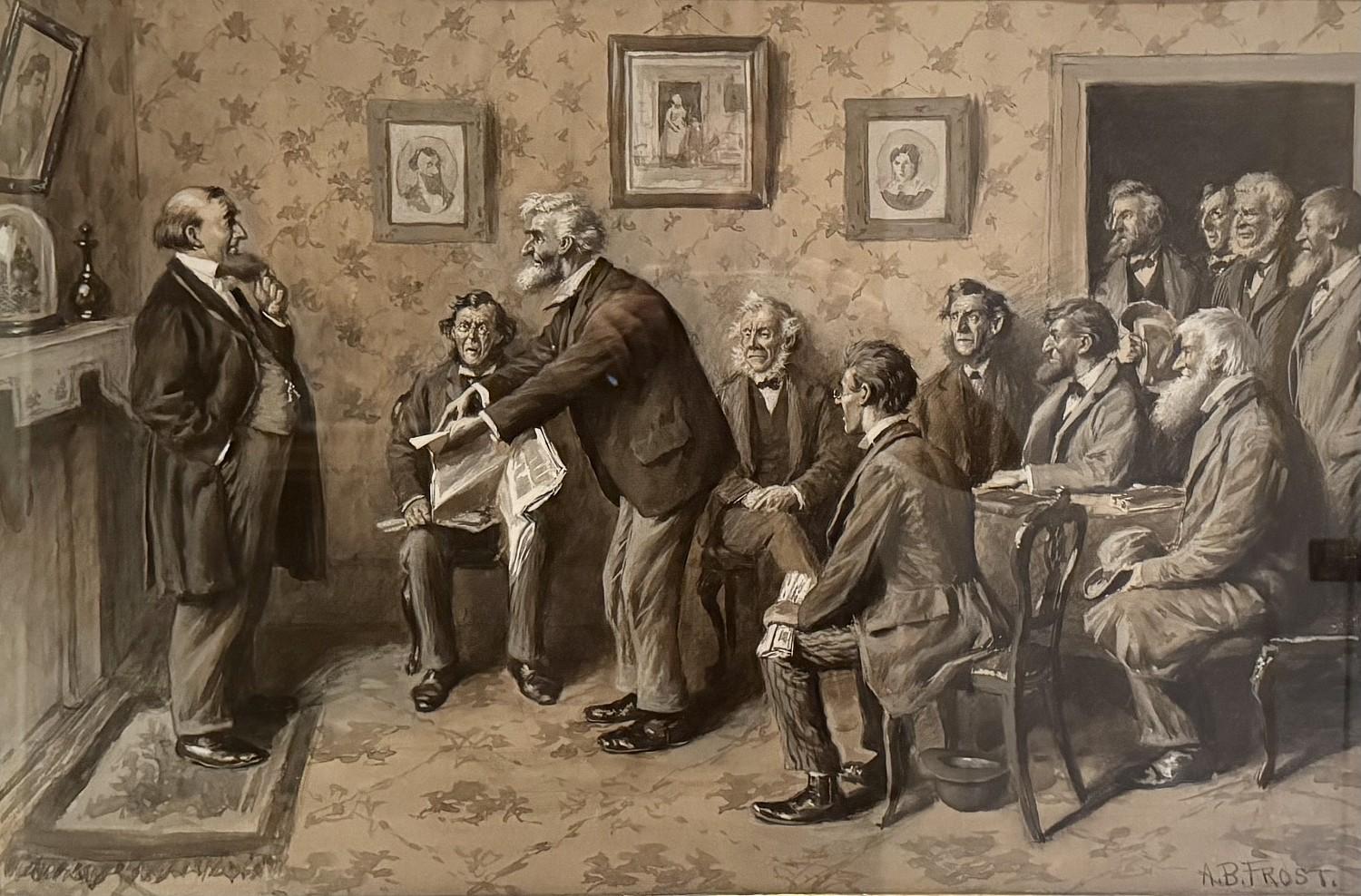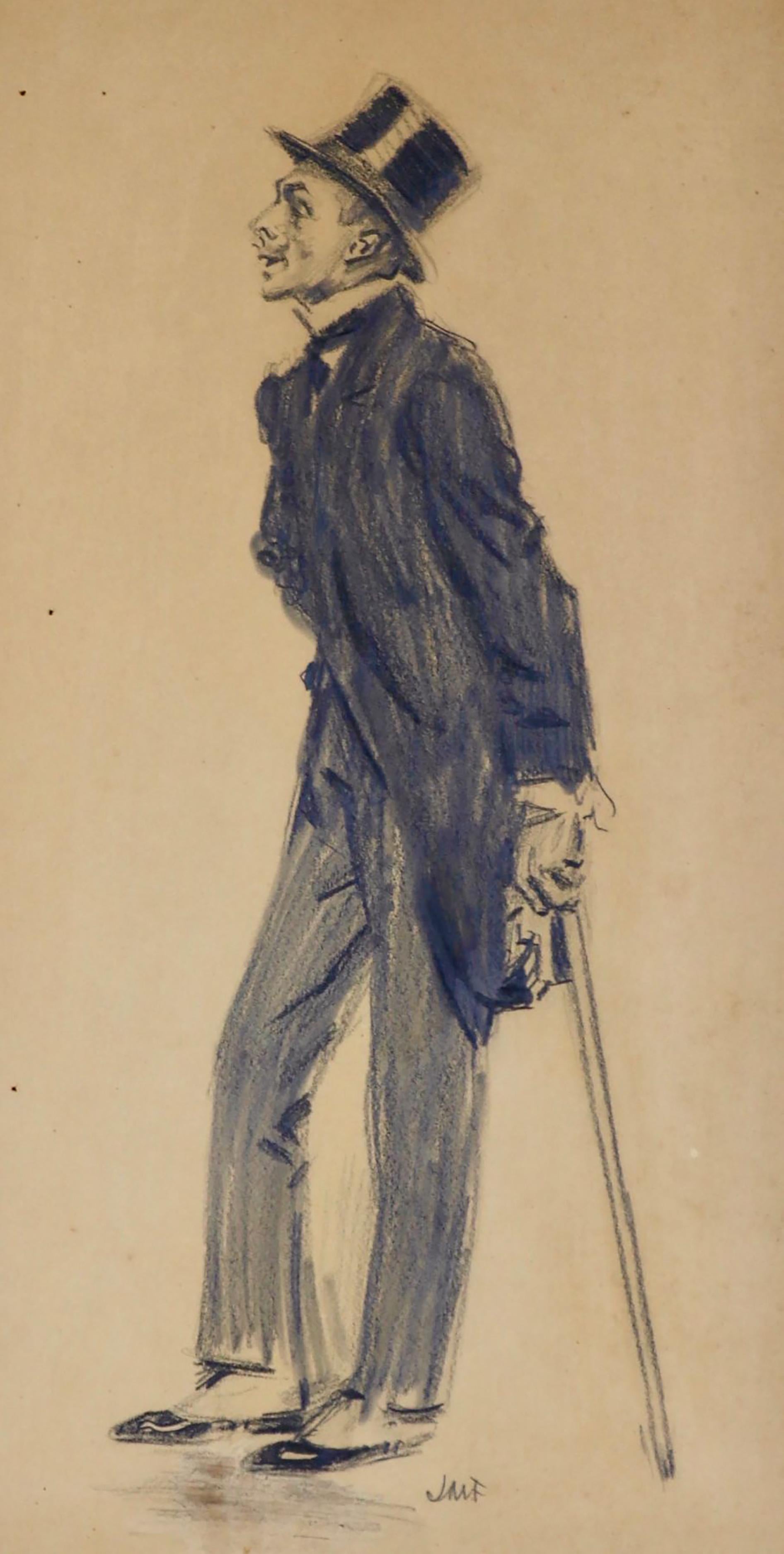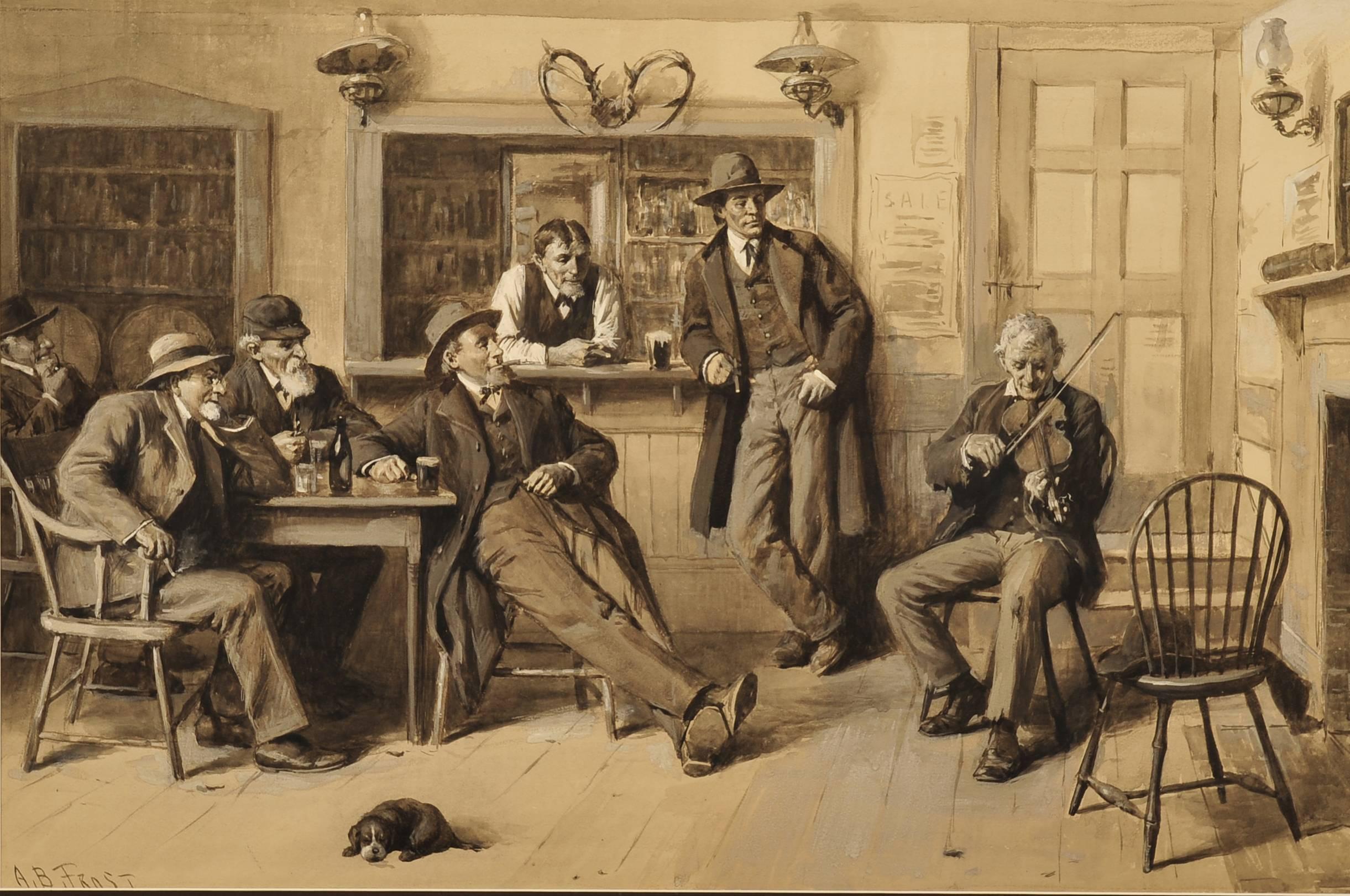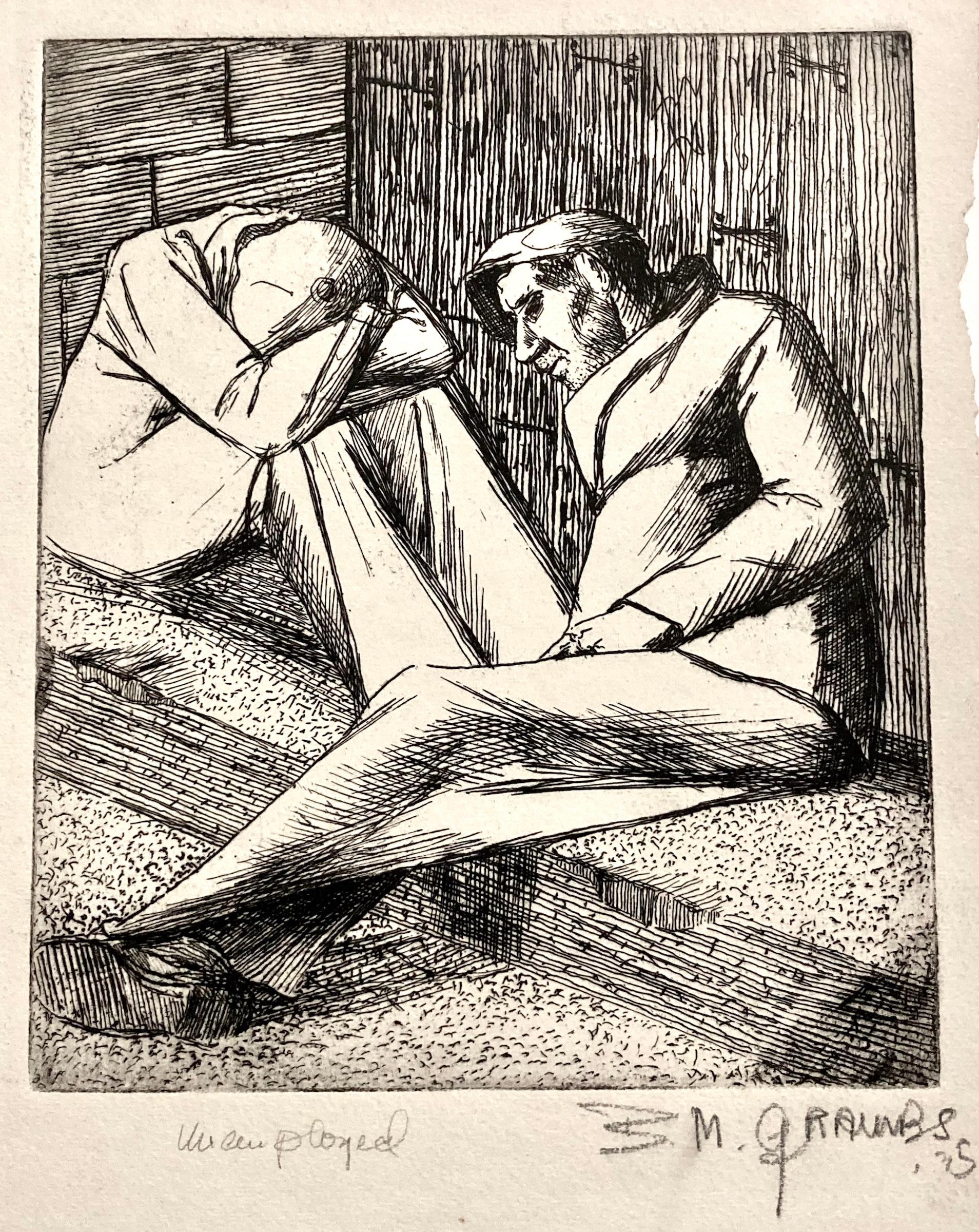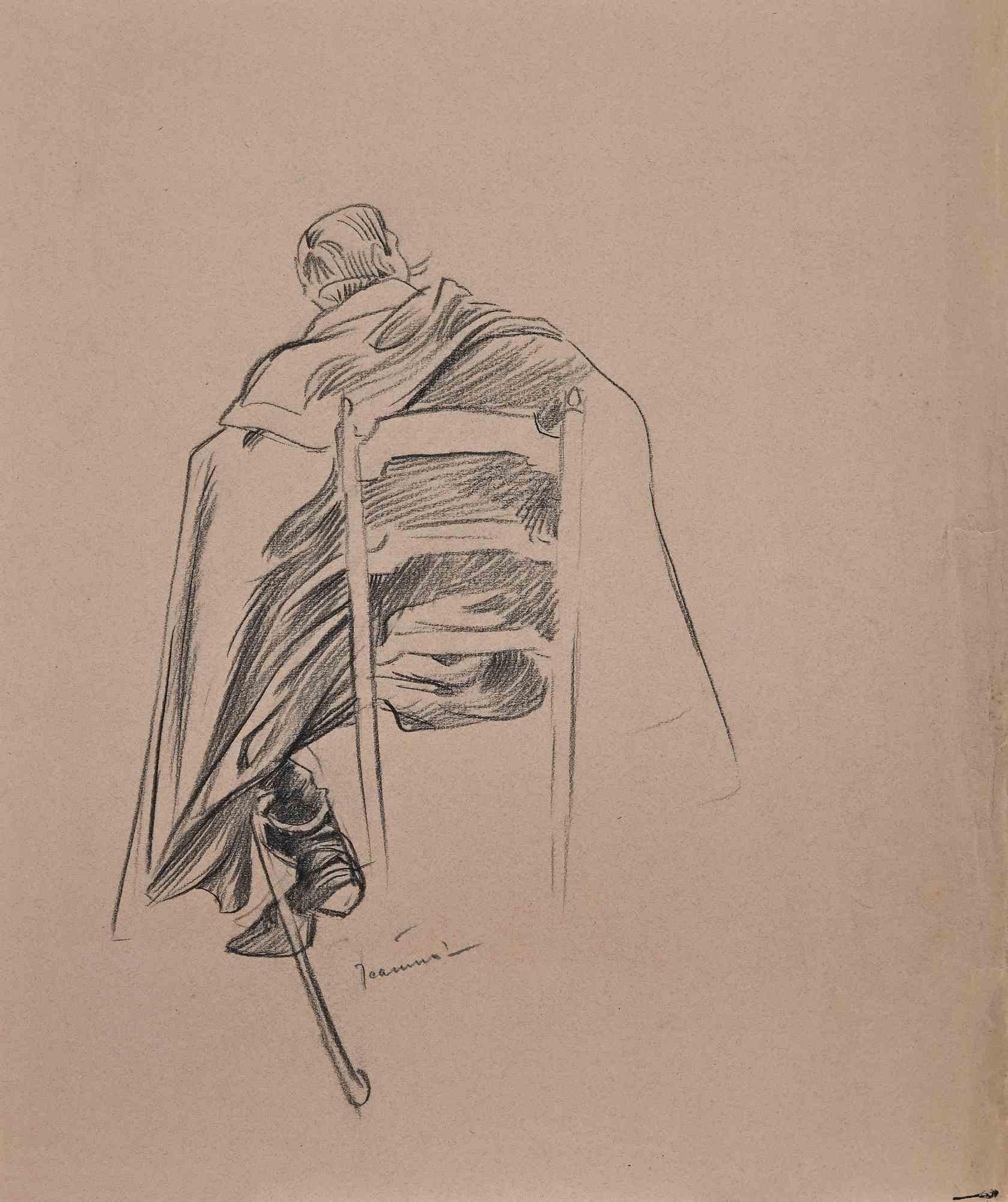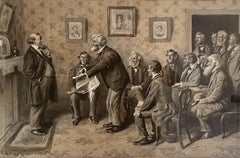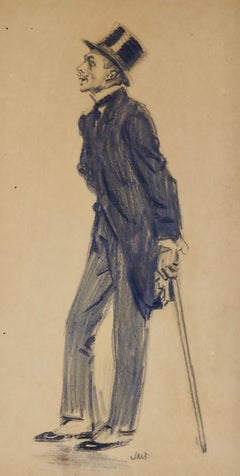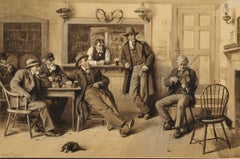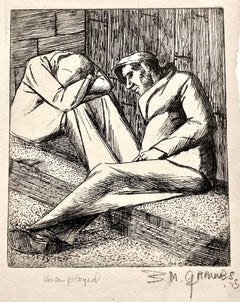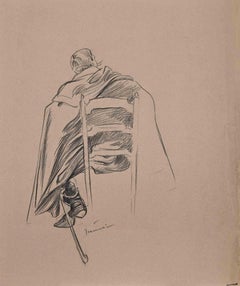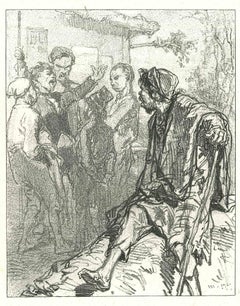Items Similar to The Peg Legged Man
Want more images or videos?
Request additional images or videos from the seller
1 of 6
Arthur Burdett FrostThe Peg Legged Man
$1,500
£1,167.85
€1,328.18
CA$2,157.71
A$2,370.62
CHF 1,238.90
MX$28,271.65
NOK 15,687.86
SEK 14,614.56
DKK 9,924.80
About the Item
The Peg Legged Man
Arthur Burdett Frost was our best illustrator of rural America. He usually treated his characters with humor, and in his drawings there was a directness and honesty which showed his sympathetic understanding of his subjects. His sound draughtsmanship was combined with an intimate knowledge of nature. The details in his pictures are always very specific, as though drawn on the spot, and so artfully chosen and placed as to carry out the picture’s idea in a natural and entirely convincing manner.
He may be best remembered now, however, for his charming illustrations for the Uncle Remus tales by Joel Chandler Harris. In the preface and dedication by Harris for the 1896 edition, he wrote of Frost “…you have conveyed into their quaint antics the illumination of your own inimitable humor, which as true to our sun and soil as it is to the spirit and essence of the matter… The book was mine, but now you have made it yours, both sap and pith…”
Frost was appreciated as a wood engraver and gravitated to work as a lithographer. His first success came with his illustrations for Out of the Hurly-Burly by Max Adler. He became a member of the Harper’s Brothers art staff alongside Abbey and Pyle, studied with Thomas Eakins and William Merritt Chase. The Frost family also sojourned in France for a long period of study for Frost and his two sons.
- Creator:Arthur Burdett Frost (1851 - 1928, American)
- Dimensions:Height: 18 in (45.72 cm)Width: 12 in (30.48 cm)
- Medium:
- Period:
- Condition:
- Gallery Location:Fort Washington, PA
- Reference Number:Seller: 27801stDibs: LU38431014373
Arthur Burdett Frost
A famous illustrator and sporting artist, Arthur B. Frost is perhaps best known for his illustrations for the Uncle Remus tales by Joel Chandler Harris, as well as for naturalistic hunting and shooting prints. Many consider him to be the best illustrator of rural America. An ardent sportsman himself, many of Frosts favorite subjects were hunting, fishing, and golfing. Often his golfing subjects tended towards humor. His scenes capture the drama of the sport - a hunter poised to shoot and a dog on point - with elements often integrated into a richly detailed woodland or marsh setting. Frost chronicled aspects of America's cultural life for over five decades. From the late 19th to the early 20th centuries, his art appeared in the many books and publications of the time, including Harper's Weekly, Scribner's, and Life magazines. Frost's illustrations always evoked the essence of a setting and its mood, whether depicting the hilarious escapades of the family cat or farm dog, or the serene pastoral lifestyle of the native northeast. His sound draftsmanship was combined with an intimate knowledge of nature. Frosts details in his pictures were very specific, as though drawn on the spot, and done in a very convincing manner. In the preface and dedication by Harris of his book Uncle Remus, Harris wrote of Frost "you have conveyed into their quaint antics the illumination of your own inimitable humor, which is as true to our sun and soil as it is to the spirit and essence of the matter. The book was mine, but now you have made it yours, both sap and pith" Other well known examples of Frosts illustrations are Brer Fox and Brer Rabbit from The Tar Baby. Frost was known to have spent time in the art colony of Rockport, on the Eastern Shore of Cape Ann, Massachusetts, where he is said to have gone because of painter Gilbert Tucker Margeson. He also summered at the noted Shinnecock Hills Summer School of Art, which William Merritt Chase set up a few miles west of Southampton, New York. Shinnecock Hills became the best known of all the out-of-doors summer art schools that developed in America during the late nineteenth century, and attracted hundreds of aspiring young men and women, including Frost, Rockwell Kent, Lydia Field Emmet, and many others. Frost was red-green color blind, but it was not a great handicap since the majority of his work was reproduced in black and white. He managed to work successfully in color by reading the labels on the tubes and placing the colors in the proper order on his palette. Arthur Frost is the father of impressionist painter John Frost (b. 1890 in Philadelphia - 1937), and as a young man John studied art with his father before going on to study in Europe.
About the Seller
5.0
Recognized Seller
These prestigious sellers are industry leaders and represent the highest echelon for item quality and design.
Established in 1995
1stDibs seller since 2016
140 sales on 1stDibs
Typical response time: 1 hour
- ShippingRetrieving quote...Shipping from: Fort Washington, PA
- Return Policy
More From This Seller
View All"His Constituents" illustration for the poem "The Day of Reckoning"
By Arthur Burdett Frost
Located in Fort Washington, PA
The image features a political discussion.
Published to accompany the poem “The Day of Reckoning” in Drawings by A. B. Frost (New York: Duffield & Co.), 1904. Subsequently released ...
Category
Early 1900s Figurative Paintings
Materials
Paper, Watercolor
Men Reading the Newspaper
By Arthur Burdett Frost
Located in Fort Washington, PA
Story illustration, image of a man reading the newspaper surrounded by other men.
Arthur Burdett Frost was our best illustrator of rural Ameri...
Category
19th Century Other Art Style Paintings
Materials
Watercolor
Man with Cane and Top Hat
By James Montgomery Flagg
Located in Fort Washington, PA
Initialed Lower Right
Category
20th Century Mixed Media
Materials
Charcoal, Board, Graphite
The Itinerant Fiddler
By Arthur Burdett Frost
Located in Fort Washington, PA
Date: 1890
Medium: Watercolor en Grisaille
Dimensions: 18.00" x 26.75"
Signature: Signed Lower Left
Editorial illustration, image of a man playing a violin with other men looking on...
Category
1890s Figurative Drawings and Watercolors
Materials
Watercolor
"The Breaking Point" Man Comes in from the Cold
Located in Fort Washington, PA
A monochromatic painting by Thornton Skidmore depicting two figures in a rustic interior. The work is characterized by bold brushwork and strong contrast, with attention to texture a...
Category
20th Century Paintings
Materials
Oil
"Heah's a few little trinkets I picked up" or "Phil and the Judge"
By Arthur Burdett Frost
Located in Fort Washington, PA
"Heah's a Few Little Trinkets I Picked Up," or "Phil and the Judge"
Probable book or magazine illustration showing the character named Phil in front of a judge.
Artwork Dimension...
Category
Early 1900s Figurative Paintings
Materials
Paper, Watercolor
You May Also Like
Blanche Grambs, Unemployed
Located in New York, NY
Blanche Grambs, known to friends as 'Grambs' (1916-2010) was born in China. She came to New York as a very young woman to study at the Art Students Leag...
Category
1930s Ashcan School Figurative Prints
Materials
Etching
Man Sitting - Drawing by G. Jeanniot - Late 19th Century
By Pierre Georges Jeanniot
Located in Roma, IT
Man Sitting is an Original Pencil Drawing realized by Pierre Georges Jeanniot (1848-1934).
Hand-Signed by the artist on the lower margin.
Good condition on a brown colored cardboa...
Category
Late 19th Century Modern Drawings and Watercolor Paintings
Materials
Pencil
The Misery - Original Lithograph by Paul Gavarni - 1881
By Paul Gavarni
Located in Roma, IT
The Misery is an original lithograph artwork on ivory-colored paper, realized by the French draftsman Paul Gavarni (after) (alias Guillaume Sulpice Chevalier Gavarni, 1804-1866) in P...
Category
1880s Modern Figurative Prints
Materials
Lithograph
Attrib. Gordon Browne RI, RBA (1858-1932) - c.1913 Pen & Ink Drawing, Mr. Craig
Located in Corsham, GB
A pen and ink drawing attributed to the well known British artist Gordon Frederick Browne. Label to the reverse reads 'Gordon Frederick Browne RI, RB (1858-1932) Son of 'Phiz'. Exhib...
Category
20th Century Figurative Drawings and Watercolors
Materials
Pen
Beggar with a Wooden Leg
Located in Middletown, NY
Etching on handmade wove paper, 3 3/4 x 2 3/4 inches (95 x 70 mm), thread margins. Third state (of five), likely printed early 19th century. In very good condition with light handlin...
Category
17th Century Old Masters Figurative Prints
Materials
Etching, Handmade Paper
Figure - Original Lithograph - 19th Century
Located in Roma, IT
Figure is an original lithograph on paper realized by Anonymous Artist of 19th Century.
In good conditions except for some stains.
The artwork represents a man. The artwork is depi...
Category
Late 19th Century Figurative Prints
Materials
Lithograph
More Ways To Browse
Vintage Pegging
Thomas Eakins
Vintage Chandlers
Peg Art
Large Scale Paintings
Portrait Of A Woman
Oil Painting Oranges
19th Century Original Oil Paintings
New Orleans Art
Framed Nude
21st Century Modern Paintings
Used Paint Brushes
Small Painting Of A Tree
1950 Oil Paintings
Large Antique Oil Painting Framed Paintings
Custom Vintage Frames
White Acrylic Painting
Green And Blue Flower Art
